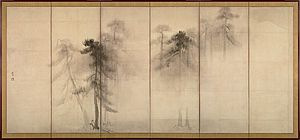Hasegawa Tōhaku facts for kids
Quick facts for kids
Hasegawa Tōhaku
長谷川 等伯 |
|
|---|---|
| Born | 1539 Nanao, Noto Province, Japan
|
| Died | March 19, 1610 |
| Nationality | Japanese |
| Known for | Painting (Sumie) |
|
Notable work
|
|
| Movement | Hasegawa school |
| Patron(s) | Toyotomi Hideyoshi, Tokugawa Ieyasu |
Hasegawa Tōhaku (長谷川 等伯, 1539 – March 19, 1610) was a famous Japanese painter. He started his own unique painting style, known as the Hasegawa school.
He is considered one of the greatest painters from the Azuchi–Momoyama period (1573-1603). Tōhaku is most famous for his large folding screens called byōbu. Some of his most well-known works include Pine Trees and Pine Tree and Flowering Plants. These are so important that they are considered National Treasures of Japan. He also created beautiful paintings for walls and sliding doors at the Chishaku-in temple, some with his son, which are also National Treasures.
Contents
Hasegawa Tōhaku's Early Life and Art
Hasegawa Tōhaku was born in 1539 in a town called Nanao. This area is now part of Ishikawa Prefecture in Japan. His birth name was Okumura Tōhaku. His family were known for dyeing cloth. Later, he was adopted into the Hasegawa family.
Tōhaku began his art career painting for Buddhist temples in his home province of Noto. By the time he was 20, he was a professional painter. In his thirties, he moved to Kyoto, a major city for art and culture. There, he studied with the very famous Kanō school. This school was led by Kanō Shōei at the time.
Learning from the Kanō School
The Kanō school was well-known for its big, bold paintings. These artworks often decorated the walls of castles owned by wealthy warlords. Their paintings were usually done with ink on white paper or used gold leaf. The gold leaf panels helped to reflect light in the dim castle rooms. They also showed off how rich the castle owner was, as commissioning such art was very expensive.
Many of Tōhaku's earlier paintings show the style of the Kanō school. An example is his painting Maple at Chishaku-in, which he created in 1593.
Developing His Own Style
While in Kyoto, Tōhaku also studied older styles of ink painting. He looked at scrolls from the Song and Yuan dynasty in China, and from Japan's Muromachi period. He likely saw these important artworks at the Daitoku-ji temple in Kyoto.
After some time, Tōhaku developed his own unique style of Sumie (ink wash painting). His style was different from the bold techniques of the Kanō school. It went back to the simpler, more minimalist look of earlier masters. The works of Sesshū Tōyō, another great Japanese painter, especially influenced Tōhaku. Tōhaku even studied for a while with Sesshū's student, Toshun. Tōhaku admired Sesshū's art so much that he tried to claim he was Sesshū's fifth successor.
The influence of Sesshū can be seen in many of Tōhaku's later works. His famous Shōrin-zu byōbu (松林図 屏風) Pine Trees screen is a great example. This painting is a National Treasure of Japan. It is believed to be one of the first large-scale paintings to feature only pine trees as its main subject.
The Hasegawa School
The painting school founded by Hasegawa Tōhaku is known as the Hasegawa school. This school was small, mostly made up of Tōhaku and his sons. However, its members kept Tōhaku's quiet and calm artistic style. Many believe this style was influenced by Sesshū and Tōhaku's friend, Sen no Rikyū, a famous master of the tea ceremony. It is thought that these simple aesthetics were a way to protest the show of wealth and power often seen in the Kanō school's art.
Tōhaku's main rival was Kanō Eitoku. They often competed for the support of powerful leaders like Toyotomi Hideyoshi. After Eitoku died in 1590, Tōhaku became the most important living master of his time. He became the official painter for Hideyoshi. Under Hideyoshi's support, Tōhaku created some of his most beautiful and elegant paintings. He and his workshop created the wall and screen paintings for the Shoun-ji temple in 1593. These paintings were later moved to the Chishaku-in temple in Kyoto and are still there today.
When Tōhaku was 67, he was called to Edo (which is now Tokyo). There, the shōgun Tokugawa Ieyasu gave him the special priestly title of hōgen. Tōhaku stayed in Edo for the rest of his life.
See also
 In Spanish: Hasegawa Tōhaku para niños
In Spanish: Hasegawa Tōhaku para niños



